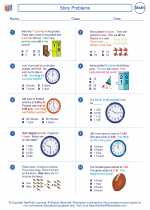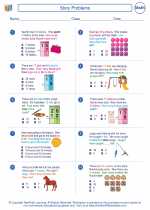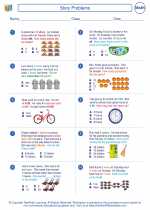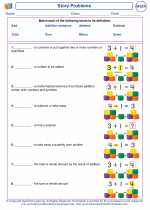Story Problems
Story problems, also known as word problems, are mathematical problems presented in the form of a story. These problems require students to apply their math skills to real-life situations, helping them develop critical thinking and problem-solving abilities.
Steps to Solve Story Problems
- Read the Problem: Carefully read the entire story problem to understand the situation and what is being asked.
- Identify the Math Operations: Determine which mathematical operations (addition, subtraction, multiplication, division) are needed to solve the problem.
- Translate the Information: Convert the words in the story problem into mathematical expressions or equations.
- Solve the Problem: Use the identified math operations and information to solve the problem and find the answer.
- Check Your Answer: Verify the solution and ensure that it makes sense in the context of the story problem.
Types of Story Problems
Story problems can cover a wide range of mathematical concepts, including arithmetic, fractions, decimals, geometry, measurement, and more. Common types of story problems include:
- Addition and Subtraction: Problems involving combining or taking away quantities.
- Multiplication and Division: Problems related to equal groups, sharing, or scaling quantities.
- Comparison: Problems requiring comparisons between quantities or groups.
- Time and Money: Problems related to telling time, counting money, and making change.
- Fractions and Decimals: Problems involving parts of a whole or parts of a set.
Tips for Solving Story Problems
When tackling story problems, it's helpful to:
- Highlight key information in the problem.
- Draw diagrams or pictures to visualize the situation.
- Use manipulatives or objects to model the problem.
- Break down complex problems into smaller, more manageable steps.
- Check the solution by applying it back to the original story problem.
By practicing story problems, students can enhance their mathematical reasoning skills and apply their knowledge to real-world scenarios.
.◂Math Worksheets and Study Guides Second Grade. Story Problems
Study Guide Story Problems
Story Problems  Worksheet/Answer key
Worksheet/Answer key Story Problems
Story Problems  Worksheet/Answer key
Worksheet/Answer key Story Problems
Story Problems  Worksheet/Answer key
Worksheet/Answer key Story Problems
Story Problems  Worksheet/Answer key
Worksheet/Answer key Story Problems
Story Problems  Vocabulary/Answer key
Vocabulary/Answer key Story Problems
Story Problems 

 Worksheet/Answer key
Worksheet/Answer key
 Worksheet/Answer key
Worksheet/Answer key
 Worksheet/Answer key
Worksheet/Answer key
 Worksheet/Answer key
Worksheet/Answer key
 Vocabulary/Answer key
Vocabulary/Answer key

The resources above cover the following skills:
Number and Operations (NCTM)
Understand numbers, ways of representing numbers, relationships among numbers, and number systems.
Develop a sense of whole numbers and represent and use them in flexible ways, including relating, composing, and decomposing numbers.
Connect number words and numerals to the quantities they represent, using various physical models and representations.
Understand meanings of operations and how they relate to one another.
Understand various meanings of addition and subtraction of whole numbers and the relationship between the two operations.
Understand the effects of adding and subtracting whole numbers.
Compute fluently and make reasonable estimates.
Develop and use strategies for whole-number computations, with a focus on addition and subtraction.
Develop fluency with basic number combinations for addition and subtraction.
Algebra (NCTM)
Represent and analyze mathematical situations and structures using algebraic symbols.
Use concrete, pictorial, and verbal representations to develop an understanding of invented and conventional symbolic notations.
Use mathematical models to represent and understand quantitative relationships.
Model situations that involve the addition and subtraction of whole numbers, using objects, pictures, and symbols.
Measurement (NCTM)
Understand measurable attributes of objects and the units, systems, and processes of measurement.
Recognize the attributes of length, volume, weight, area, and time.
Grade 2 Curriculum Focal Points (NCTM)
Number and Operations and Algebra: Developing quick recall of addition facts and related subtraction facts and fluency with multi-digit addition and subtraction
Children use their understanding of addition to develop quick recall of basic addition facts and related subtraction facts. They solve arithmetic problems by applying their understanding of models of addition and subtraction (such as combining or separating sets or using number lines), relationships and properties of number (such as place value), and properties of addition (commutativity and associativity). Children develop, discuss, and use efficient, accurate, and generalizable methods to add and subtract multi-digit whole numbers. They select and apply appropriate methods to estimate sums and differences or calculate them mentally, depending on the context and numbers involved. They develop fluency with efficient procedures, including standard algorithms, for adding and subtracting whole numbers, understand why the procedures work (on the basis of place value and properties of operations), and use them to solve problems.
Connections to the Grade 2 Focal Points (NCTM)
Number and Operations: Children use place value and properties of operations to create equivalent representations of given numbers (such as 35 represented by 35 ones, 3 tens and 5 ones, or 2 tens and 15 ones) and to write, compare, and order multi-digit numbers. They use these ideas to compose and decompose multi-digit numbers. Children add and subtract to solve a variety of problems, including applications involving measurement, geometry, and data, as well as nonroutine problems. In preparation for grade 3, they solve problems involving multiplicative situations, developing initial understandings of multiplication as repeated addition.